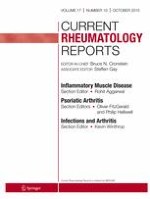Published in:

01-10-2015 | Inflammatory Muscle Disease (Myositis) (R Aggarwal, Section Editor)
Myositis Mimics
Authors:
E. Harlan Michelle, Andrew L. Mammen
Published in:
Current Rheumatology Reports
|
Issue 10/2015
Login to get access
Abstract
Patients with autoimmune myositis typically present with muscle weakness, elevated serum levels of muscle enzymes, and abnormal muscle biopsies. However, patients with other acquired myopathies or genetic muscle diseases may have remarkably similar presentations. Making the correct diagnosis of another muscle disease can prevent these patients from being exposed to the risks of immunosuppressive medications, which benefit those with myositis, but not those with other types of muscle disease. Here, we review some of the most common acquired and inherited muscle diseases that can mimic autoimmune myositis, including inclusion body myositis, limb girdle muscular dystrophies, metabolic myopathies, mitochondrial myopathies, and endocrine myopathies. We emphasize aspects of the medical history, physical exam, laboratory evaluation, and muscle biopsy analysis that can help clinicians distinguish myositis mimics from true autoimmune myositis.